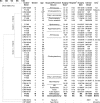Epidemic of postsurgical infections caused by Mycobacterium massiliense
- PMID: 19403765
- PMCID: PMC2708466
- DOI: 10.1128/JCM.00027-09
Epidemic of postsurgical infections caused by Mycobacterium massiliense
Abstract
An epidemic of infections after video-assisted surgery (1,051 possible cases) caused by rapidly growing mycobacteria (RGM) and involving 63 hospitals in the state of Rio de Janeiro, Brazil, occurred between August 2006 and July 2007. One hundred ninety-seven cases were confirmed by positive acid-fast staining and/or culture techniques. Thirty-eight hospitals had cases confirmed by mycobacterial culture, with a total of 148 available isolates recovered from 146 patients. Most (n = 144; 97.2%) isolates presented a PRA-hsp65 restriction pattern suggestive of Mycobacterium bolletii or Mycobacterium massiliense. Seventy-four of these isolates were further identified by hsp65 or rpoB partial sequencing, confirming the species identification as M. massiliense. Epidemic isolates showed susceptibility to amikacin (MIC at which 90% of the tested isolates are inhibited [MIC(90)], 8 microg/ml) and clarithromycin (MIC(90), 0.25 microg/ml) but resistance to ciprofloxacin (MIC(90), >or=32 microg/ml), cefoxitin (MIC(90), 128 microg/ml), and doxycycline (MIC(90), >or=64 microg/ml). Representative epidemic M. massiliense isolates that were randomly selected, including at least one isolate from each hospital where confirmed cases were detected, belonged to a single clone, as indicated by the analysis of pulsed-field gel electrophoresis (PFGE) patterns. They also had the same PFGE pattern as that previously observed in two outbreaks that occurred in other Brazilian cities; we designated this clone BRA100. All five BRA100 M. massiliense isolates tested presented consistent tolerance to 2% glutaraldehyde. This is the largest epidemic of postsurgical infections caused by RGM reported in the literature to date in Brazil.
Figures




Similar articles
-
Outbreaks due to Mycobacterium abscessus subsp. bolletii in southern Brazil: persistence of a single clone from 2007 to 2011.J Med Microbiol. 2014 Oct;63(Pt 10):1288-1293. doi: 10.1099/jmm.0.074906-0. Epub 2014 Jul 18. J Med Microbiol. 2014. PMID: 25038135 Free PMC article.
-
Emergence of nosocomial Mycobacterium massiliense infection in Goiás, Brazil.Microbes Infect. 2008 Nov-Dec;10(14-15):1552-7. doi: 10.1016/j.micinf.2008.09.008. Epub 2008 Oct 4. Microbes Infect. 2008. PMID: 18950729
-
Cohort study of molecular identification and typing of Mycobacterium abscessus, Mycobacterium massiliense, and Mycobacterium bolletii.J Clin Microbiol. 2009 Jul;47(7):1985-95. doi: 10.1128/JCM.01688-08. Epub 2009 May 6. J Clin Microbiol. 2009. PMID: 19420162 Free PMC article.
-
Multiphasic approach reveals genetic diversity of environmental and patient isolates of Mycobacterium mucogenicum and Mycobacterium phocaicum associated with an outbreak of bacteremias at a Texas hospital.Appl Environ Microbiol. 2008 Apr;74(8):2480-7. doi: 10.1128/AEM.02476-07. Epub 2008 Feb 29. Appl Environ Microbiol. 2008. PMID: 18310417 Free PMC article.
-
Mycobacterium thermoresistibile: case report of a rarely isolated mycobacterium from Europe and review of literature.Indian J Med Microbiol. 2009 Jul-Sep;27(3):264-7. doi: 10.4103/0255-0857.53214. Indian J Med Microbiol. 2009. PMID: 19584513 Review.
Cited by
-
In Vitro Antimicrobial Susceptibility of Mycobacterium massiliense Recovered from Wound Samples of Patients Submitted to Arthroscopic and Laparoscopic Surgeries.Minim Invasive Surg. 2011;2011:724635. doi: 10.1155/2011/724635. Epub 2011 Jan 4. Minim Invasive Surg. 2011. PMID: 22110914 Free PMC article.
-
Non-tuberculous mycobacterial infection in hospitalized children: a case series.Epidemiol Infect. 2015 Nov;143(15):3173-81. doi: 10.1017/S0950268815000333. Epub 2015 Mar 12. Epidemiol Infect. 2015. PMID: 25762105 Free PMC article.
-
Autophagy as a Target for Drug Development Of Skin Infection Caused by Mycobacteria.Front Immunol. 2021 May 25;12:674241. doi: 10.3389/fimmu.2021.674241. eCollection 2021. Front Immunol. 2021. PMID: 34113346 Free PMC article. Review.
-
Resazurin Microtiter Assay for Clarithromycin Susceptibility Testing of Clinical Isolates of Mycobacterium abscessus Group.J Clin Lab Anal. 2016 Sep;30(5):751-5. doi: 10.1002/jcla.21933. Epub 2016 May 12. J Clin Lab Anal. 2016. PMID: 27169515 Free PMC article.
-
Multilocus sequence analysis and rpoB sequencing of Mycobacterium abscessus (sensu lato) strains.J Clin Microbiol. 2011 Feb;49(2):491-9. doi: 10.1128/JCM.01274-10. Epub 2010 Nov 24. J Clin Microbiol. 2011. PMID: 21106786 Free PMC article.
References
-
- Adekambi, T., P. Berger, D. Raoult, and M. Drancourt. 2006. rpoB gene sequence-based characterization of emerging non-tuberculous mycobacteria with descriptions of Mycobacterium bolletii sp. nov., Mycobacterium phocaicum sp. nov. and Mycobacterium aubagnense sp. nov. Int. J. Syst. Evol. Microbiol. 56133-143. - PubMed
-
- Adékambi, T., and M. Drancourt. 2004. Dissection of phylogenetic relationships among 19 rapidly growing Mycobacterium species by 16S rRNA, hsp65, sodA, recA and rpoB gene sequencing. Int. J. Syst. Evol. Microbiol. 542095-2105. - PubMed
-
- Alvarenga, L., D. Freitas, A. L. Hofling-Lima, R. Belfort, Jr., J. Sampaio, L. Sousa, M. Yu, and M. Mannis. 2002. Infectious post-LASIK crystalline keratopathy caused by nontuberculous mycobacteria. Cornea 21426-429. - PubMed
Publication types
MeSH terms
Substances
Associated data
- Actions
- Actions
- Actions
- Actions
- Actions
- Actions
LinkOut - more resources
Full Text Sources
Medical
Molecular Biology Databases
Research Materials

